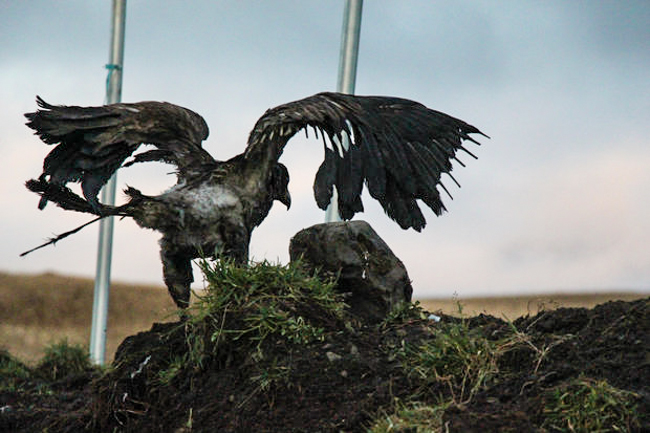
It’s common practice to burn trash in the Aleutians to keep landfills from overflowing. But it’s not that simple in Adak, where flaming waste has killed or injured at least ten bald eagles in the last few months. Now it’s now the subject of a federal investigation.
Bald eagles are born to hunt — but they’re also excellent scavengers. If there’s food around that’s easy to get, eagles will go after it. And there’s no easier target for an eagle than the dump.
Keith Hamilton found that out first-hand when he started a job with Adak’s public works crew. Part of his job was to burn trash:
“I noticed right away in November when I started working there that there was birds being burnt and I found a few dead eagles out there, and I complained right away about it.”
When bald eagles get hurt or killed, Adak’s municipal employees are supposed to contact the U.S. Fish and Wildlife Service right away.
That’s because bald eagles are protected under federal law. The penalties are steep — possible jail time, and fines of up to $250,000. If it’s an organization that’s at fault, the fine could go all the way up to a half a million dollars.
Hamilton says he asked his supervisor in Adak to report the eagles – but he also says those requests were brushed aside.
And that didn’t sit well with him.
“You know, animals have souls. If you would see those birds out there — limping around the fire, eating garbage with no feathers. And they couldn’t leave the fire pit, they were just trapped there. If anybody really looked at them, they would feel bad.”
When Hamilton came across three eagles at the dump in December – scorched, but alive — he didn’t bother calling his boss or the authorities. He called an Anchorage bird sanctuary.
“All I was trying to do in December was just quietly send off some birds to the hospital get treatment.”
But it didn’t stay quiet. The rescue attracted the attention of the Anchorage Daily News. And one of their reporters reached out to Adak’s city manager, Layton Lockett.
Lockett says that that phone call was the first he’d heard about bald eagles getting burned or killed at his town’s dump.
“Up until these series of events, we had never had a problem to my knowledge or to my employees’ knowledge as well.”
Lockett says Adak took steps to fix it. They quit burning trash for most of the winter and buried it instead. And the city started to build a $25,000 enclosure for the burn pit.
But it wasn’t quite done before public works employees decided to burn trash there again at the end of February. Hamilton was there, and he noticed eagles all around the edge of the fire.
“I had a bad feeling. They made me leave the dump. I came back the next day, looked around and I started spotting more eagles that were injured.”
At one point, Hamilton was stopped by an Adak police officer, who allegedly told Hamilton he’d be breaking federal law if he picked up a bald eagle – even if he was just trying to help it.
That’s not true, according to Ryan Noel. He’s a special agent with the U.S. Fish and Wildlife Service.
“In fact, the Fish and Wildlife Service would encourage a person who finds an eagle that’s in distress to take careful measures to try and save it.”
But they can’t be sure that everything in Adak has happened by the books. Noel says that’s why the Fish and Wildlife sent an agent and a biologist to the island this week to investigate.
“We look to see if there was any intent to do any harm, and to determine if there was in fact. And then obviously would refer that information on to the U.S. attorney’s office. And they would determine if there was any grounds for prosecution.”
While they’re in Adak, the Fish and Wildlife team will also be a resource to city officials, who are looking into safe options for keeping eagles out of the dump. With the right federal permits, Adak could use lights and sirens to try to spook the birds away.
For now, the city’s focused on the renovated burn pit at the dump. They’re going to ask the federal investigators to check and make sure it’s up to their standards.
And until then, Adak isn’t going to burn any more of its trash.
And as for Keith Hamilton – the city worker who started all this? It depends on who you ask: Hamilton says he was fired for his activities at the dump, while the city of Adak says he was just put on a temporary leave.
Either way, Hamilton’s not going back to his old job. And he feels he did the right thing:
“We have so many eagles over here. I think people just overlook them, thinking, ‘Oh, well. One dead eagle. We’ve got plenty more.’ But they were suffering. I would do it for any animal, or human.”
Even if that animal is a notorious scavenger.
